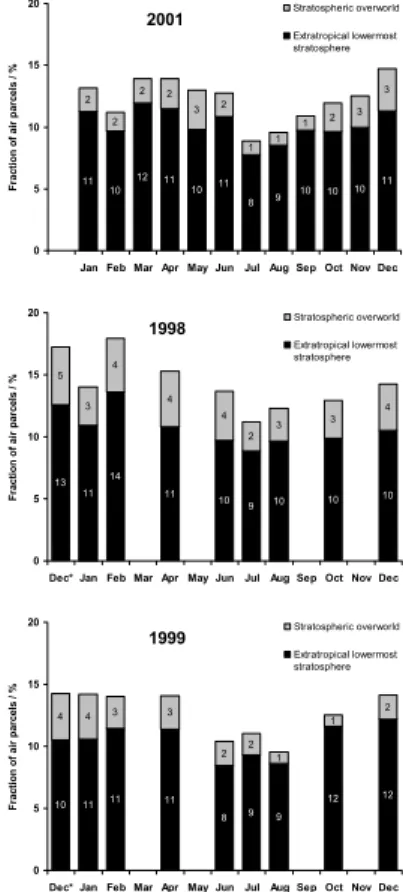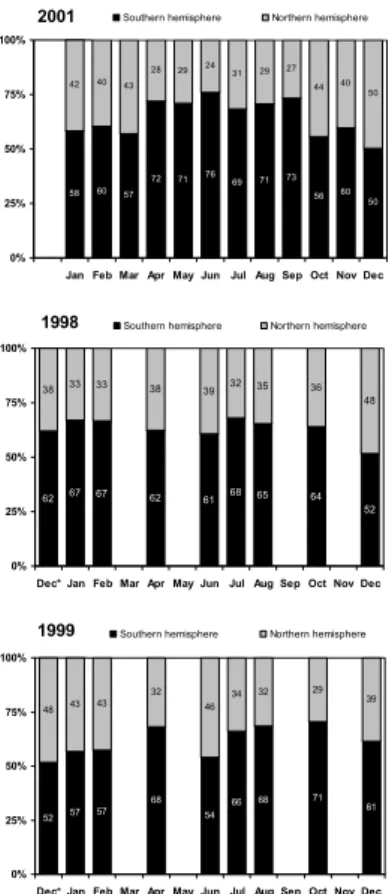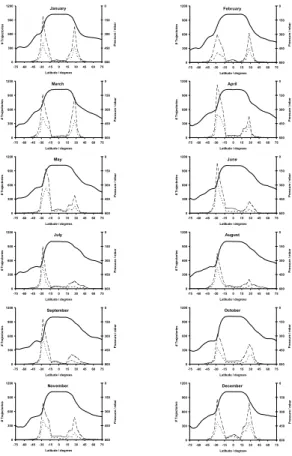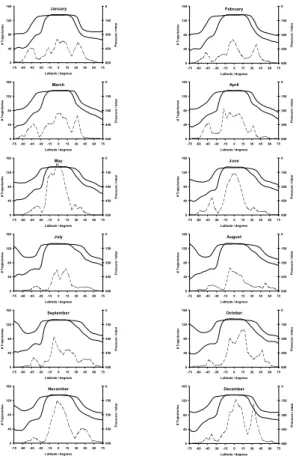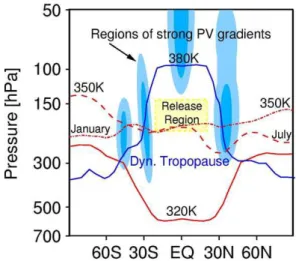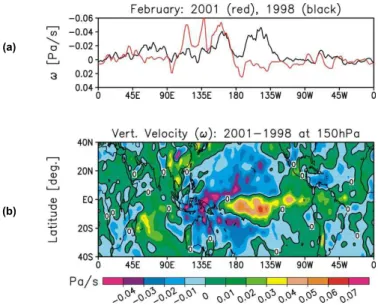Here, as in our previous study, we explore TST from the base of the TTL, including transport to the ELS and across the globe. We will investigate the effect of the ENSO on the routes through which air parcels undergo TST from the base of the TTL. We examine variations in the amount of TST from the base of the TTL in Sect.
Therefore, the trajectories are believed to be reasonably representative of the large-scale ascent observed in the tropics. Therefore, it appears that one of the key findings of our previous study (Levine et al., 2007) is robust to time variation: most air parcels undergoing TST from the base of TTL undergo transport to ELS. Regardless of season and year, the vast majority of air parcels subject to TST, between 70 and.
To this extent, the homogeneity of TST relative to the base of the TTL identified in January 2001 (see Levine et al., 2007) appears robust to timing change. In terms of air entry into the stratosphere, larger than average fractions of the air undergoing TST enter the stratosphere. During the NH winter (e.g. January), the shape of the tropopause in the subtropics is roughly symmetrical with respect to the equator and a non-disparate portion of the air parcels enters the stratosphere.
Apparently at this time of year air packages have been released to the base of the.
ACPD
With the exception of a period in early 1998, much of the air transported to the upper world comes between approx. 50 and 75%, from the regions of the TTL over Indonesia (red) and the western Pacific (dark yellow);. However, this does not mean that the same fraction of air enters every region of the world. It also appears that a greater proportion of the air enters the upper world over South America (dark green) during late summer/early fall (eg August/September) than at any other time of year.
By extending our previous research (Levine et al., 2007) over several years, we found that transport to the ELS consistently forms the major route by which air undergoes TST from the base of the TTL. We also found that the amount of TST calculated in the subtropics is sensitive to the definition of the tropopause; see Section. Regardless of the season and year, much more transport occurs to the ELS than to the overworld, as evidenced by the greater proportion of air parcels found in the ELS (about 10%) than in the overworld (about 2%). weeks after release at the base of the TTL.
Furthermore, the variations Mote et al. 1996) identified in the velocity of the so-called atmospheric tape recorder is consistent with the mass flux estimates of Rosenlof and Holton (1993) and Rosenlof. In an attempt to explain the overall bias against TST in the SH, we have investigated seasonal variations in the shape of the dynamical tropopause and the distribution of TST across it. The large-scale ERA-40 wind fields provided by ECMWF reveal a strong annual cycle in zonal and meridional winds near the base of the TTL.
The onset of the Indian summer monsoon in June is a major contributor to sea-. Throughout 2001 (baseline) and 1999 (La Ni ˜na), between 70 and 90% of the air undergoing transport to the upper world comes from the regions of the TTL over Indonesia and the western Pacific; see fig. Zonal averaging obscures the longitudinal structure in the vertical velocities encountered near the bottom of the TTL (150 hPa).
The fraction of air parcels released at the base of the TTL in each month of 2001 (baseline), 1998 (El Ni ˜no) and 1999 (La Ni ˜na) found in the stratosphere (subdivided into the stratospheric upper world and the extratropical lower stratosphere) four weeks later. The fraction of air parcels undergoing TST from the base of the TTL in each month of 2001 (baseline), 1998 (El Ni ˜no) and 1999 (La Ni ˜na) that (a) originate in each region of the TTL and ( b)enter every region of the stratosphere; the TTL and the stratosphere are divided into 45◦ intervals in longitude, with “Africa” spanning 0–45◦ , the “Indian Ocean” spanning 45–90◦ , and so on. The fraction of air parcels undergoing TST from the base of the TTL in each month of 2001 (baseline), 1998 (El Ni ˜no), and 1999 (La Ni ˜na) that enter the stratosphere (i.e., cross the tropopause) in each hemisphere .
The pressure/latitude cross section of the zonal mean monthly mean dynamic tropopause (solid black line), as defined in Sect. The pressure/latitude cross-section of the zonal-mean monthly thermal tropopause (thick black line), as defined by the World Meteorological Organization (WMO, 1957), superimposed on the frequency distribution of latitudes (5◦ bins) where air parcels enter the stratosphere (ie, crossing the tropopause) in each month of 2001 (dashed black line). 7. The fraction of air parcels undergoing transport to the upper world from the bottom of the TTL in each month of 2001 (baseline), 1998 (El Ni ˜no), and 1999 (La Ni ˜na) which (a) originated from each region of TTL and(b) enter each region of the overworld; The TTL and the overworld are divided into 45◦ intervals of longitude, with “Africa” spanning 0–45◦ , “Indian Ocean” spanning 45–90◦ , and so on.
The data comes from the ERA-40 analyzes of the European Center for Medium-Range Weather Forecasts.
